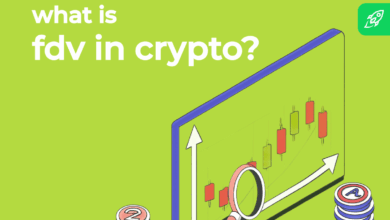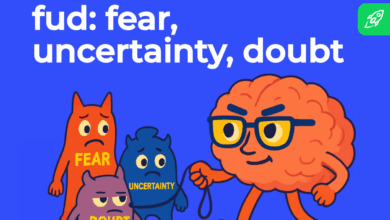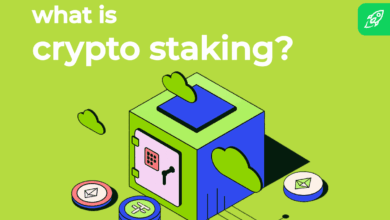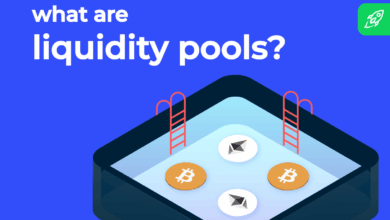What It is & Why it Matters

Real-world assets (RWAs) are becoming one of the most important trends in blockchain. By turning real estate, bonds, and other tangible assets into digital tokens, RWAs bridge traditional finance and decentralized ecosystems.
In this RWAs crypto guide, you’ll learn what RWAs are, how tokenization works, why they’re gaining momentum, and what top projects are leading the space.
What are Real World Assets (RWAs) in crypto?
Real-World Assets (RWAs) are tangible assets like real estate, gold, or stocks. These exist outside the blockchain. You can tokenize them and bring them into the crypto space using digital tokens.
Once brought on-chain, RWAs become tokenized assets. Each token represents a real item or financial instrument. You can hold a digital token for part of a house, a barrel of oil, or a government bond.
RWAs give you a new way to access physical assets through blockchain. You don’t need to buy a building or a gold bar. You can own a small portion of them instead.
RWAs cover a wide range of items:
- Real estate – Apartments, homes, land
- Commodities – Gold, oil, and raw materials
- Stocks and bonds – Shares, corporate and government debt
- Art and collectibles – Rare items, luxury goods, and fine art
These assets gain a new form when tokenized. They become programmable, tradable 24/7, and accessible worldwide.
By using blockchain, tokenized assets gain transparency and liquidity. You can track every transaction. You can also transfer ownership without middlemen.
RWAs connect real-world value to blockchain technology. That link opens massive opportunities for growth and innovation.
Why are Real World Assets (RWAs) important in blockchain?
RWAs connect traditional markets with blockchain. They let you invest in real-world value using digital tools.
You can access high value assets like real estate, gold, or government bonds without needing large capital. Tokenization turns them into small, tradable units.
This expands the digital asset ecosystem. You can buy or sell tokens 24/7 without middlemen. Blockchain brings faster transactions and lower costs.
RWAs also boost liquidity. You no longer need to wait weeks to sell a property or bond. Tokens move instantly.
Security improves, too. Every ownership change is recorded on-chain. That makes transfers clear and trustworthy.
RWAs help reduce crypto’s volatility. They bring real-world stability to digital finance.
They also attract users who trust tangible value more than pure crypto. That makes RWAs a powerful gateway for adoption.
By linking real assets with blockchain, RWAs create a more open, secure, and stable financial system.
Types of Real World Assets (RWAs) Tokenization
Real-World Asset (RWA) tokenization comes in different forms. The structure depends on the type of asset and the investment model. The two most common formats are fungible vs non-fungible tokens, and fractional ownership.
Fungible vs Non-Fungible Tokens (NFTs)
Fungible tokens are interchangeable. Each unit has the same value and can be traded like money. These tokens work well for physical assets like gold or oil, and for financial products such as treasury bonds or stablecoins.
For example, PAX Gold (PAXG) is a fungible token. Each one represents one ounce of gold held in reserve. Investors can trade small amounts instead of buying whole gold bars.
Non-fungible tokens (NFTs) are unique. You can’t swap one NFT for another, since each token represents something different. This format is ideal for real estate, artwork, or intellectual property.
Propy, a real estate platform, once sold a Florida home through an NFT. The buyer received a token tied to the property’s legal rights. This simplified the purchase process and cut transaction times.
Fractional Ownership and Accessibility
Fractional tokenization lets you own a small part of large real world assets (RWAs). This model is transforming real estate investment, luxury goods, and collectibles.
You no longer need to buy an entire building or painting. Platforms like RealT and Lofty split assets into thousands of tokens, enabling fractional ownership for as little as $50.
This opens the door for casual investors. You can hold a portion of income-generating property and earn rent passively.
Thanks to blockchain technology, these shares are easy to trade. You can buy or sell them instantly. No banks or brokers needed.
This model also links directly with decentralized finance (DeFi). Investors can use tokenized shares as collateral or join liquidity pools. This creates a more open and efficient financial system.
How Blockchain Integrates RWAs
Tokenization: Converting RWAs into Digital Assets
Asset tokenization is the technical bridge between physical assets and blockchain. It starts by assigning legal ownership of an asset—like real estate, commodities, or other valuable assets—to a legal wrapper such as an LLC or SPV.
Then, a smart contract is deployed on-chain to issue digital tokens. These tokens represent shares of ownership. The contract defines how many tokens exist, how they’re transferred, and who can hold them.
Each token contains metadata and links to off-chain records—like appraisals or legal documents—stored on IPFS or similar systems. This structure gives the token legal and financial backing.
Tokenization allows small investors to access high-priced items. And since these tokens live on a blockchain, they can be traded 24/7 with transparent pricing. That turns illiquid assets into programmable units of global financial value.
What are LLC and SPV?
- LLC (Limited Liability Company): A legal business structure that separates the owner’s personal assets from the business. In RWA tokenization, an LLC can be set up to hold ownership of a real-world asset. The blockchain token then represents shares in that LLC.
- SPV (Special Purpose Vehicle): A legal entity created for a specific purpose, like owning a single property or asset. It isolates financial and legal risk. In tokenization, the SPV holds the asset, and investors buy tokens representing shares of that SPV.
In short: both LLCs and SPVs act as legal wrappers. They hold the physical asset, and the blockchain token gives you a claim to ownership through that entity. This structure helps tie the real-world asset to the on-chain token legally and securely.
Smart Contracts and RWA Transactions
Smart contracts enforce how real-world assets behave on-chain. They replace manual processing with automated logic.
In an RWA system, smart contracts verify compliance. For example, they check KYC/AML status before allowing transfers. Only whitelisted wallets can interact with token contracts. This protects the system from bad actors.
These contracts also manage events like dividend payouts, interest distribution, or rental income. Functions can be triggered manually or by oracles that feed off-chain data—such as valuation updates or payment confirmations.
Each contract defines asset rules: who can transfer, under what conditions, and when redemptions occur. This makes fraud nearly impossible, since the rules are baked into the code.
But RWAs still require off-chain action. Unlike fully on-chain DeFi, tokenized assets depend on regulated actors—like custodians, asset managers, and trustees—who manage legal ownership, hold collateral, and ensure compliance in the real world.
This introduces some centralization. But it’s necessary to bridge blockchain logic with legal systems, maintain security, and build trust with investors.
Smart contracts reduce operational risk and lower administrative costs. They ensure every transaction follows legal frameworks and executes exactly as written.
This blend of smart automation and real-world enforcement turns RWAs into trusted digital infrastructure.
How RWAs Are Used in Crypto Today
Tokenizing real-world assets is one of the fastest-growing trends in crypto. By bringing traditional finance instruments onto blockchain, investors gain access to stable yields, real-world exposure, and greater liquidity. Let’s explore the key use cases.
You can track the entire tokenized asset space with platforms like RWA.xyz — a leading analytics tool that monitors on-chain issuance, asset performance, and market trends across stablecoins, private credit, treasuries, and more. As of early 2025, it reports over $17.5 billion in tokenized assets across 12+ blockchains, giving investors a clear view of how RWAs are growing and evolving.

Stablecoins and Asset-Backed Tokens
Stablecoins are the largest RWA category, with a market cap of $235 billion. Backed by cash or short-term treasuries, USDT and USDC dominate with a 90% market share and $521 billion in average monthly transaction volume. They enable instant, borderless payments and are core to the crypto economy.
Beyond fiat-backed coins, other digital assets include gold, private credit, and tokenized stocks. These combine off-chain value with on-chain flexibility, making them useful in both DeFi and traditional trading environments.
Private Credit
Tokenized private credit is the leading RWA asset class by loan volume, reaching $12.2 billion—up 62% year-on-year. Investors lend capital to real-world borrowers, secured by RWA-backed collateral. Figure leads the sector with $9.5 billion in active loans and its own credit marketplace, Figure Connect. DeFi protocols like Centrifuge, Goldfinch, and Maple also drive loan origination and repayment through smart contracts.
Treasuries
Tokenized U.S. treasuries have surged, hitting a $5.2 billion market cap and growing 383% year-on-year. These low-risk, high-liquidity tokens offer on-chain access to treasury yields. Major players include BlackRock’s BUIDL, Franklin Templeton’s FOBXX, and Hashnote’s USYC. They appeal to institutions and individuals seeking safer yield opportunities in a decentralized setting.
Commodities
Tokenized commodities hold $1.3 billion in market value, mostly in gold. Paxos Gold (PAXG) and Tether Gold (XAUT) lead the space. Each token gives fractional ownership of a physical commodity, letting users invest in assets like gold or silver without storage concerns.
Tokenized Stocks
Stocks can also be tokenized and traded on-chain. Exodus Movement’s tokenized Class A shares (EXOD) on Algorand lead this category, which holds a $486 million market cap. These tokens enable faster settlement, digital dividends in USDC, and on-chain corporate governance. However, they still face tight regulation under the SEC.
Real Estate and Other RWAs
Real estate tokenization allows investors to hold fractions of properties. Platforms like RealT and Lofty offer access to rental income and capital appreciation with low entry costs. Other tokenized assets include corporate bonds, private equity, and non-US sovereign debt, now worth over $600 million. These solutions improve accessibility, especially for illiquid markets, and support on-chain lending, trading, and collateralization.
Popular Projects That Use RWAs
Ethereum: The RWA Powerhouse
Ethereum dominates the RWA space, securing 54% of the market share. Its robust security and vast developer ecosystem make it the go-to platform for tokenizing assets. Institutions like BlackRock have launched tokenized funds here, such as the USD Institutional Digital Liquidity Fund (BUIDL), offering on-chain access to traditional assets. Ethereum’s compatibility with various tools and widespread adoption continue to attract RWA projects, solidifying its leadership in the sector.
zkSync Era: Scaling RWAs Efficiently
As a Layer-2 solution for Ethereum, zkSync Era holds 26% of the tokenized RWA market, managing over $1.78 billion across 27 projects. Utilizing Zero-Knowledge Rollups (ZK-Rollups), it enhances transaction speed and reduces costs while maintaining Ethereum’s security. Projects like Tradable leverage zkSync Era to tokenize private credit assets, benefiting from its scalability and efficiency.
MakerDAO: Integrating RWAs into DeFi
MakerDAO, the issuer of the DAI stablecoin, has increasingly integrated RWAs into its ecosystem. With a real-world asset portfolio worth approximately $3.9 billion, it now earns around 80% of its fee revenue from RWAs. Investments include U.S. Treasury bonds and other traditional assets, bridging the gap between decentralized finance and traditional finance. MakerDAO’s approach demonstrates the potential of RWAs to provide stability and yield within DeFi platforms.
Algorand: Streamlining Asset Tokenization
Algorand offers the Algorand Standard Assets (ASA) framework, enabling seamless creation and management of digital tokens representing various assets, including real estate and commodities. Its pure proof-of-stake consensus algorithm ensures secure and efficient transactions. Algorand’s focus on simplicity and scalability makes it an attractive platform for RWA tokenization projects seeking reliability and speed.
XDC Network: Bridging Trade Finance and Blockchain
XDC Network is tailored for enterprise applications, focusing on tokenizing tangible assets like real estate and financial instruments. It boasts fast transaction times, minimal fees, and interoperability with existing financial systems. Initiatives like the XDC Trade Network digitize trade finance processes, enhancing liquidity and transparency. Partnerships with entities like InvestaX and Archax further strengthen its position in compliant RWA tokenization.
Cosmos: Facilitating Interoperable RWA Solutions
Cosmos, known as the “Internet of Blockchains,” provides a decentralized network of independent, scalable, and interoperable blockchains. Its architecture attracts developers building RWA-focused applications that require cross-chain functionality. By enabling seamless communication between different blockchains, Cosmos supports the integration and management of tokenized real-world assets across diverse platforms.

Benefits of Tokenizing Real-World Assets
Enhanced Accessibility
Real world asset tokenization opens investment opportunities to more people. You can now access asset classes like real estate or private credit with small amounts of capital. This lowers the barrier to entry for new and global investors.
Increased Liquidity
Tokenization turns traditionally illiquid assets into liquid instruments. Fractional ownership and 24/7 trading enable investors to buy and sell shares anytime. You don’t have to wait weeks to exit a position.
Transparency and Trust
Blockchain provides an immutable ledger. Every transaction is visible and verifiable. This transparency builds trust and reduces fraud in ownership transfers.
Lower Costs Through Automation
Smart contracts automate asset issuance, income distribution, and transfers. They eliminate paperwork, cut legal fees, and reduce dependency on middlemen. Asset management becomes faster, cheaper, and more efficient.
Global Market Access
Tokenized assets reach beyond borders. Investors from anywhere can participate. This creates new demand and liquidity for traditional financial assets, which were once limited to local or institutional buyers. But with global reach comes regulatory complexity—and that’s where the next challenge begins.
Challenges and Risks of RWAs in Blockchain
Regulatory Uncertainty
Regulatory compliance remains complex. Legal definitions of tokenized assets vary by country. Without unified global standards, projects face delays, restrictions, or legal risk depending on jurisdiction.
Market Adoption and Infrastructure
Adoption is growing but uneven. While firms like BlackRock and JPMorgan are exploring tokenization, many institutions still hesitate. Valuation, custody, and verification of physical assets remain significant challenges. These gaps slow down ecosystem growth for tokenized real world assets.
Security and Smart Contract Risks
Smart contracts can fail. Bugs, exploits, or poor coding may lead to losses. Blockchain platforms must be audited, monitored, and regularly updated. Without strong security, the trust behind tokenized assets weakens.
The Future of RWAs in Crypto
The growth of real-world asset (RWA) tokenization is accelerating. As of February 2025, over ~$17.8 billion in RWAs have been moved on-chain—a 455% increase in just three years. This shift signals more than hype. It’s a fundamental change in how the world manages and invests in value.
Currently, tokenized RWAs—including stablecoins—account for a market capitalization of around $247 billion. While that’s impressive, it still represents just 0.02% of the global traditional assets market, according to Roland Berger. The gap shows just how early this movement still is.
Boston Consulting Group projects explosive growth. By 2030, tokenized RWAs could hit $16.1 trillion—roughly 10% of global GDP. This expansion will include everything from treasury assets to real estate and private credit, offering more flexible and secure ways to hold value.
A flywheel effect is already forming. As more financial assets are tokenized, new on-chain investment opportunities emerge. That, in turn, attracts more capital—both from crypto-native investors and traditional institutions.
Governments and asset owners are also joining the space. Their involvement will accelerate adoption by adding legitimacy and regulatory clarity. Platforms offering tokenized asset management solutions will thrive by bridging compliance with innovation.
The RWA market is still in its early stages, but the direction is clear. Tokenization will reshape how the world interacts with capital—making traditional assets programmable, portable, and available to anyone with an internet connection. The opportunity is massive—and growing by the day.
More recently, their positive sentiment towards this space has translated into real world assets (RWAs) actually being moved on-chain via tokenization. In fact, the total amount of tokenized RWAs as of February 2025 has reached ~$17.8 billion, marking a 455% increase over the prior 3 years.
FAQ
What is the best RWA crypto to buy?
There’s no one-size-fits-all answer. Top RWA tokens like Chainlink, Ondo Finance, and Mantra offer different strengths—from data oracles to yield products and compliance layers.
Some investors prefer platforms supporting real world asset collateral, while others look for exposure to U.S. treasuries or private credit. Always do your own research, assess the project’s credibility, and consider the asset backing each token.
What is the difference between Real World Assets (RWAs) and cryptocurrencies like Bitcoin or Ethereum?
RWAs represent real-world items like bonds, property, or gold. Cryptocurrencies like Bitcoin or Ethereum are native digital assets with no physical backing.
RWA tokens are backed by off-chain assets and aim to connect blockchain with financial institutions, while Bitcoin is purely decentralized and acts more like digital gold. RWAs bring tangible value into crypto, whereas cryptocurrencies rely on code, consensus, and market demand.
How does tokenization work, and why is it important for RWAs?
Tokenization converts a real asset—like a house, stock, or bond—into a digital token on blockchain. This token can be traded, owned, and used in smart contracts. Tokenization adds liquidity, transparency, and global access to assets that were once hard to divide or move. It also enables fractional ownership, making it easier for anyone to invest in tokenized real estate or private credit.
Are RWA tokens safe to invest in?
RWA tokens carry both promise and risk. Safety depends on asset custody, legal structure, and smart contract quality. Reputable platforms use licensed custodians and follow compliance rules. But since these tokens link on-chain assets with off-chain systems, trust in the issuer is key. Always research the backing, track record, and how the real world asset collateral is managed.
How can I buy or invest in RWA tokens?
You can buy RWA tokens on select crypto exchanges or directly through tokenization platforms like Ondo, RealT, or Maple. Some require KYC. Others integrate with DeFi protocols. Before investing, check what the token represents, how returns are distributed, and who manages the asset. Make sure the platform works with trusted financial institutions and provides proper legal documentation.
What are the benefits of RWAs compared to traditional investments?
RWAs combine the security of real-world backing with the flexibility of blockchain. You can invest in fractions of high-value assets, access global markets, and trade 24/7. Smart contracts reduce costs and improve transparency. Compared to traditional investments, RWAs offer lower entry barriers, faster settlement, and better liquidity—especially when holding tokenized real estate or on-chain treasuries.
Disclaimer: Please note that the contents of this article are not financial or investing advice. The information provided in this article is the author’s opinion only and should not be considered as offering trading or investing recommendations. We do not make any warranties about the completeness, reliability and accuracy of this information. The cryptocurrency market suffers from high volatility and occasional arbitrary movements. Any investor, trader, or regular crypto users should research multiple viewpoints and be familiar with all local regulations before committing to an investment.





